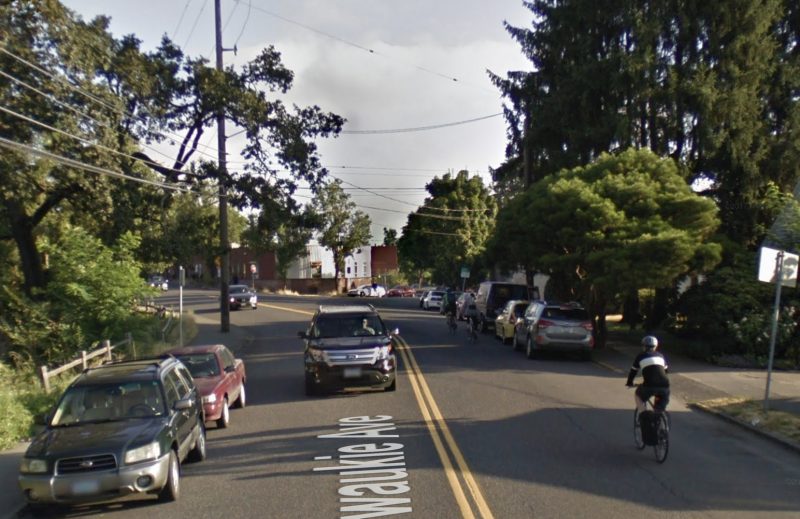
The Portland Bureau of Environmental Service (BES) has already broken ground on a major project to enhance the habitat of the Oaks Bottom Wildlife Refuge. It’s an exciting project for fish who swim in the Willamette; but for humans who ride bicycles it comes with a relatively high cost of convenience.
As we reported in January, the project will require a closure of the Springwater Corridor path for up to four months starting in July.
With just a few months until the planned closure, the Sellwood Moreland Improvement League has been lobbying BES in hopes of creating a bike detour that would be as safe and convenient as possible. BES hasn’t released detailed bike detour maps yet (they’re still in draft form, an official told me this morning), but back in January they wanted to use SE 19th as the recommended route. (They would also encourage people to cross over to the west side using the new Sellwood Bridge to connect to the Willamette Greenway path.)
19th is a nice, residential street that should have additional neighborhood greenway features added by this summer. But it’s also about 10 blocks east of the Springwater path and would require climbing and about one mile of out-of-direction travel for many bike riders.
Instead, SMILE wants BES to use SE 14th and 15th (already a calm route that goes by a school). In the northern end, SMILE also asked BES to install temporary bike lanes on SE Milwaukie Ave between Reedway and Mitchell by using space currently allocated to on-street parking. On the southern end, they asked for some crossing upgrades at SE Bybee and 14th. SMILE President Joel Lieb wrote in a February 21st letter (PDF) to BES Environmental Program Coordinator Ronda Fast that, “We want to ensure those [2,800 daily Springwater path] users have a well-planned practical and safety to her on surface streets during the closure.”
Here’s a mock-up (created by Sellwood resident William H.) showing the draft BES route and the route preferred by SMILE:
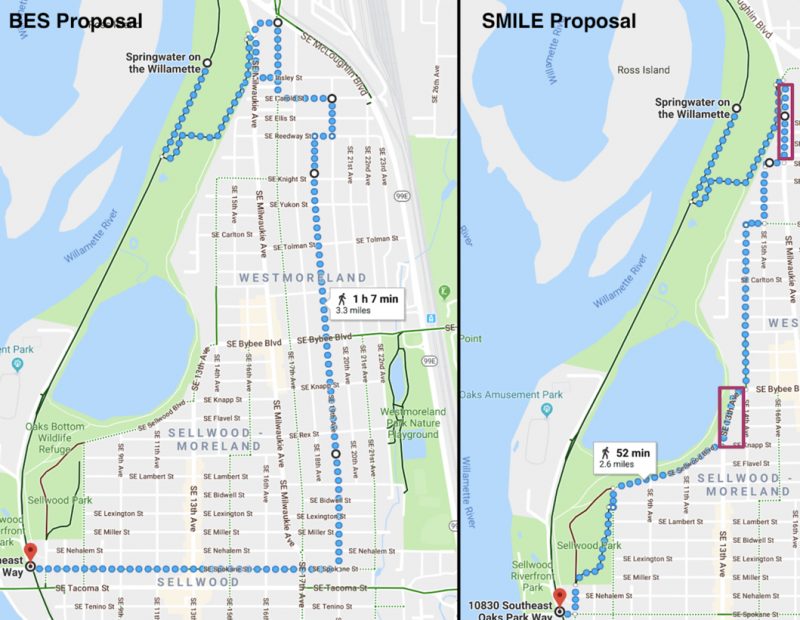
In a letter (PDF) dated April 5th, BES politely denied their requests.
Here’s the salient portion of the letter from Fast:
“After a thoughtful evaluation of your request, and after re-evaluating our plan for signage and route options with our project team, we believe that spending additional project funds on temporary bike lanes on SE Milwaukie between SE Reedway and SE Mitchell (in particular, between SE Reedway and SE Insley), is outside the scope of the project. Nor would it necessarily provide a better alternative to the established SE 19th Avenue Greenway route. We also believe that removing parking along this stretch would disrupt commercial and residential activities on that corridor, as well.
Regarding improvements at SE Bybee & 14th, the project team feels that it is also beyond the scope of the Oaks Bottom project to contribute to improvements at that intersection. When it’s fully complete this Spring, the SE 19th Avenue Greenway will include new crossing treatments, signage, and buffered bike lanes that will provide a space designed to prioritize bicycling.”

Advertisement
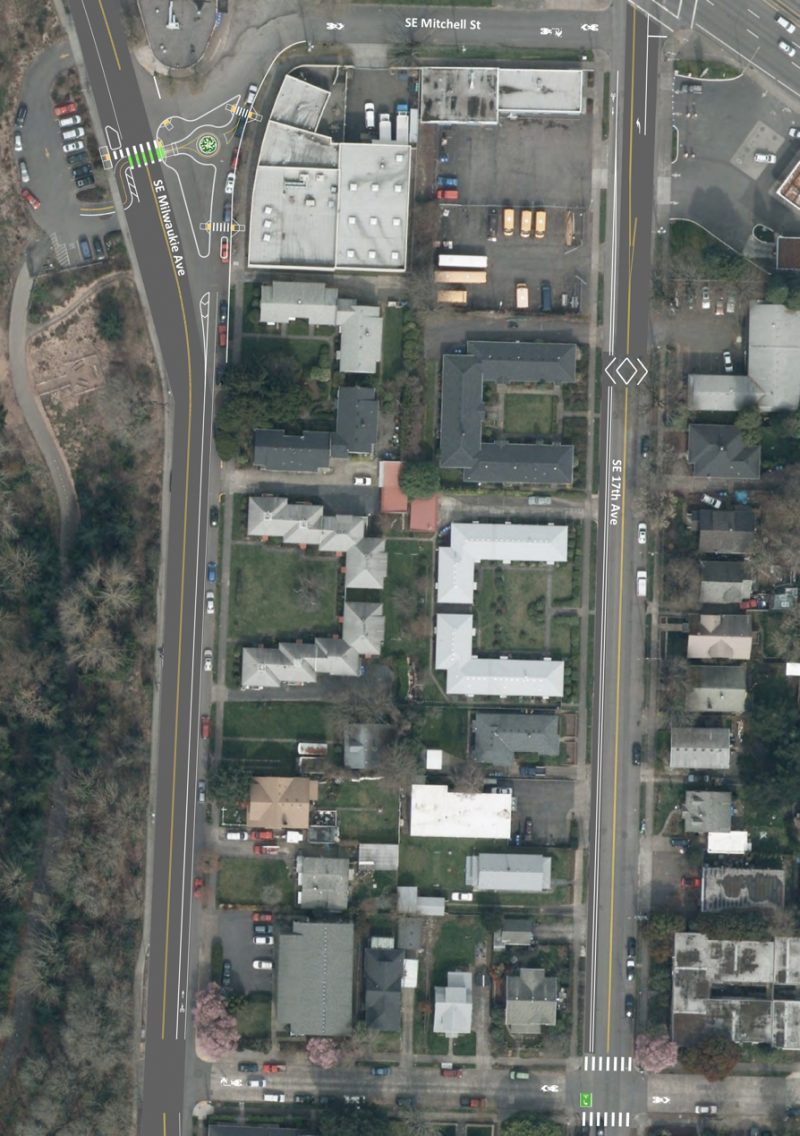
Fast added that she realizes people will continue to use Milwaukie regardless of its condition. “There are other routes and trails that we anticipate people will use based on their knowledge of the area and comfort level,” she wrote. “These two options are viable alternatives, based on feedback from our partners at PBOT and Portland Parks & Recreation, that can safely handle the increased traffic due to the closure.”
Fast also bases the decision on the Bureau of Transportation completing the 19th Avenue Neighborhood Greenway. The northern section of that project includes turning Milwaukie and 17th into a north-south bikeway couplet. Between Mitchell and Insley, Milwaukie would get a northbound, unprotected, door-zone bike lane and 17th would get an unprotected buffered bike lane southbound.
SMILE Transportation Committee Chairman Scott Kelly said the letter from Fast was, “Disappointing, to say the least.”
Another issue is whether or not BES and Portland Parks & Recreation will sign and endorse the bike detour going through Oaks Bottom Natural Area. There’s a paved multi-use path between Milwaukie (at Mitchell) and the Springwater that provides a safe connection. In that past we’ve heard Parks is concerned about increased bike use on this path due to its long downhill that could lead to high biking speeds in a popular walking/hiking area.
Reached on the phone today, BES Public Information Officer Diane Dulken said the bike tour maps are still in draft form. A staffer from BES and from PP&R will present their current plan and ask for feedback from the City of Portland Bicycle Advisory Committee at their monthly meeting tomorrow (4/10).
— Jonathan Maus: (503) 706-8804, @jonathan_maus on Twitter and jonathan@bikeportland.org
Never miss a story. Sign-up for the daily BP Headlines email.
BikePortland needs your support.

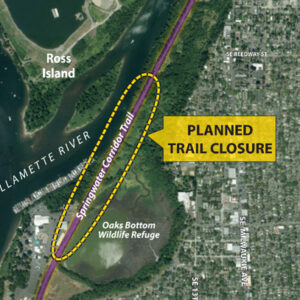

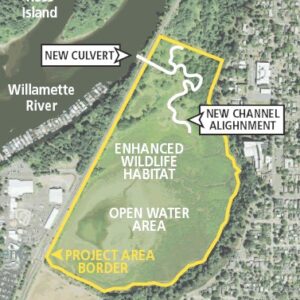
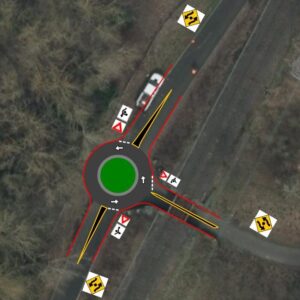
Thanks for reading.
BikePortland has served this community with independent community journalism since 2005. We rely on subscriptions from readers like you to survive. Your financial support is vital in keeping this valuable resource alive and well.
Please subscribe today to strengthen and expand our work.
wow… I have been aware of this upcoming closure in the 40 Mile Loop/Springwater on the Willamette for some time and have been wondering what would be proposed for a detour during the months of closure. I do not know nearly as much about this project as the neighbors and project team, but wow!!! …I was surprised to read details in this article.
Three things that struck me right away as I read this:
1) “we believe that spending additional project funds on temporary bike lanes on SE Milwaukie between SE Reedway and SE Mitchell (in particular, between SE Reedway and SE Insley), is outside the scope of the project.”
How does spending project funds on a safe and convenient detour qualify as “out of scope?”
2) Nor would it necessarily provide a better alternative to the established SE 19th Avenue Greenway route.
What criteria are being used to come to the conclusion that this requested detour is no better than the SE19th route? It seems that the neighborhood strongly disagrees with the project team and bikeportland provides reasons above why it is better than SE 19th.
3) We also believe that removing parking along this stretch would disrupt commercial and residential activities on that corridor, as well.
Parking is temporarily removed ALL THE TIME for construction projects such as this. Again, what criteria is being used to determine that a) significant harm will be caused to commercial and residential activities and b) that this alleged harm outweighs the public benefits of a convenient bicycle and pedestrian detour through the area–a detour that was requested BY THE NEIGHBORHOOD ASSOCIATION, whose members are the residents and commercial establishment operators in this area?
What am I missing here? I would love to understand the thinking behind the above statements.
I’ll be at the BAC meeting tomorrow night Scott and I have a feeling BES will have to answer these questions. Stay tuned.
I’ll do what I can to ask them tomorrow night, this topic doesn’t have much time allocated. BES has a pretty poor track record from first-hand experience when it comes to detours involving bikes and pedestrians. They have to do better with this project if any of this talk of increasing bike mode share is something the city values.
Good questions Scott. (The same I had.) Perhaps a FOIA needs to be issued to BES (COP) for the analysis on this…
…and per the ADA / Access Board (etc) …does the long term planned “detour” route provide an ADA route that is “as good or better” than the one being closed by construction?…perhaps BES will need to reconsider the 14th /15th request so as to incorporate ADA and help bikes too…I assume Federal and or State money is funding this work?
As someone who has been advocating for the completion of the 19th ave Greenway project, this is really frustrating. The initial versions of the project didn’t provide any safe connection to the Springwater. The final version has a really great crossing which will hugely improve the connection for people walking, but it is connected to a door zone unprotected bikelane. Rather than providing protection, PBOT simply lowered the speed limit so that the unprotected bike lane would not violate their own PBL policy. However, the most recent speed study showed 85th percentile speeds at 32mph. The southbound bike lane on 17th will also be unprotected (but at least not in the doorzone).
If PBOT has done the work to make the 19th ave Greenway a true 8-80 option, perhaps I’d believe that people will go significantly out of their to use it. As it stands I expect most people to bike with the fast moving traffic on Milwaukie, just as they do today.
One clarification: this unprotected bike lane has not actually been built yet. There’s still time to get it right…
Is there any chance they could remove the yellow striping on both Milwaukie and on 17th, and make the street look like a local street? It’s been pretty effective on slowing traffic on 130th and on Mill east of 130th, both of which are also collector streets.
I don’t really care about so-called protection and usually find that it puts me at greater risk of harm than a standard, six-plus foot bike lane. However, putting a bike lane in the door zone is so early 1970s. Haven’t we learned our lesson yet? Hint: car doors open without warning. If someone happens to be riding in a door-zone bike lane when that occurs, very bad things, like death or maiming, happen.
It’s very disappointing to find that dzbl’s are still even allowed around here. No wonder bike modal share is stuck in place.
Free automobile storage spaces are the third rail of this “green” and “sustainable” city. Parking almost always trumps modern and safe facilities for people rolling or walking.
At some of the earlier meetings with PBOT staff it was pretty clear they were afraid to remove car storage spots (“parking”) on the street.
I don’t see a problem with using 19th as the main Alt route.
I don’t see much climbing unless someone lives almost on the water near the sellwood bridge…
Why would someone already on 19th not just keep going north and cross McLaughlin at 17th and go all the way to Tilikum Crossing.? and vise-versa..Tilikum to 17th to 19th to springwater…
I do this every day, and it’s fine. It’s doable, the question is who is doing it. As a fit young male experienced rider, it’s usually fine for me. At least, it’s fine during non peak hours when I don’t have my kids and the weather is good.
For others, it’s going to pale in comparison to a ride on the Springwater. These users will likely have an issues with a route that involves taking the lane, crossing a highway, biking with no protection from vehicles on a major trucking route and crossing MAX tracks multiple times, etc.
There is a whole square mile of developed land in Sellwood-Moreland west of 19th. I believe at least 5000 people in this area, and about 3/4 of them will have a detour of at least a 1/4 mile, up to 1/2 mile, each way, to use the Greenway on 19th instead of 14th/15th or the Springwater.
Also, 19th is slightly downhill from the main plateau of Sellwood, so people to the west of 17th would need to ride back uphill to 17th while heading north (or south). It’s also out of the way of the connection to the Springwater at Mitchell, which Jonathan spoke of in the article.
19th is terrific, especially if you enter it right from the Springwater. That said, you clearly haven’t attempted a crossing of 99E at 17th. It’s one of the largest, fastest, loudest crossings in the city. Add to that, if a train comes through, they ignore your crossing light as a non-motor vehicle and the cycle starts right back over again. And again, when the second train comes through.
Some serious improvements need be made there before I recommend it, which is sad since it is a primary bicycle network connection.
Pro tip: if you push the beg button it will give you a crossing signal even if the train comes. And kudos to PBOT for fixing that in response to my 823-SAFE request =).
It warms my heart to see the concern that BES has for the health and safety of the cycling public. Look out Mother Teresa, Michael Jordan and his crew are coming for your nobel prize.
there are an awful lot of folks at BES who ride, so I’m surprised that the requested detour route was given such short shrift.
but to your point, a great many BES employees work there precisely because they care about the health and safety of the public. I can’t credibly argue that they haven’t missed the mark pretty badly so far on this one, though. here’s hoping they shape up.
I will be using SE 14th and SE 15th whether or not the city cooperates in making it a better temporary detour. I expect most who already know biking in this area will do the same. Why go all the way down to 19th?
As a former Brooklynite who frequently between home and Sellwood, I’ve always been frustrated by this section of Milwaukie. The proposed 19th Avenue alternative requires a more convoluted route and TWO crossings of busy streets: Milwaukie itself, and 17th.
I’d actually have found it acceptable to ride on the west sidewalk of Milwaukie – if it were wider. It’s too narrow for cyclists and pedestrians to pass each other comfortably, and in a couple spots there are are poles in the middle of the sidewalk that make it difficult to get by with a wider rig like a cargo bike or a trailer. There’s one mid-sidewalk post that is impossible for many bikes to pass on its west side, but also difficult or impossible to pass on its east side if a car is parked there.
But if a temporary bike lane on Milwaukie is “out of scope”, so I’m sure is relocating these pesky non-compliant utility poles.
But a temporary bike lane on Milwaukie is the only acceptable solution, IMO.
Has there been any talk of finally repairing/repaving the wrinkled/bumpy section(s) of the Westside Greenway Trail in anticipation of the closure? I anticipate many will use the Westside trail, and those bumps are nasty.
Those are maintained by whoever owns the property.
Fixing stuff like this is not as straightforward as it sounds. Some places have a condo board that has to go through an entire process while owners already have trouble agreeing to do basic repairs like roofs. And many bumps are caused by roots — and you’re not allowed to just cut roots just because they’re wrecking the paths
As I mention in a separate comment (sorry, failure to reply correctly) the most severely degraded parts of the path are adjacent to commercial, not residential, buildings.
The root bumps are largely unmarked and dangerous. Also, there isn’t any route-finding on the Greenway trail, and when you get to the end of it, you’re greeted by a fence across the path.
If you do manage to divine your way out of the Spaghetti Factory’s parking lot, you’re then led into one of the most often blocked bicycle lanes we have to offer here in the city of roses.
Indeed. It’s interesting to watch riders accrue the knowledge that the best way past the Spaghetti Factory is to turn along a narrow strip of concrete and shortcut through the parking lot just South of the SF.
Going a bit off topic by a 1/4 mile, but speaking of gaps in the Springwater, what’s up with the section from Umatilla to SE 17th. Paved path turns to nice gravel (still rideable and runnable), then from gravel to gravelly mess (not rideable, still runnable at least).
I hate the “why are you complaining about this, you should be complaining about that!” line of thinking, but this path gap just boggles my mind. It is like, right smack in the heart of the path.
The Springwater section from Umatilla to 13th was supposed to be paved in the Summer of 2016, but it appears the project has been indefinitely delayed. Check out this article Metro published two years ago on completing the paving that Summer:
https://www.oregonmetro.gov/news/sellwood-gap-springwater-shrinking-after-metro-investments
Right now it’s best to ride the smooth gravel down to 9th and then follow SE Linn St to 17th. From there you can either use the Zebra-strip crosswalk to get back on the Springwater, or ride one block on the West sidewalk of 17th to jump directly onto the 17th Ave Multi-Use Path.
Appreciate the info! Getting it to 13th will be a nice improvement. And the remaining gap there is pretty trivial, you can sweep comfortably through the neighborhood just south.
Although… it is quite satisfying to look at a GPS track where you make this big sweeping turn through SE while hanging right alongside the tracks.
They have just moved some utility poles (last week) to prepare for the gap paving.
Let’s keep this on the DL, Silky, I use that section to train for gravel grinding.
So could a person still take the Oaks Bottom from Milwaukie to the Springwater or is that little underpass going to be a part of the closure as well? I can’t seem to find that out from the various links.
Things are still in flux Travis. We should know more after tomorrow nights advisory committee meeting.
Right on, thanks.
Oh that better not be closed too! That’s a HUGE connector for Westmoreland folks getting to/from downtown! Not to mention how many people on foot take the little trail next to the river there during the summer.
That was my question. Can you ride (against Parks’ orders) the established trail next to the river and then use informal trails to get to the road by Oaks Amusement Park?
Irregardless of the closure of the Springwater, why do the bike lanes end at SE Insley instead of SE Reedway? That would provide a direct connection to SE 19th, rather than requiring out-of-direction travel on SE 20th.
Furthermore, what’s the thinking behind putting the northbound bike lane on Milwaukie? Looking at this map above, is someone riding northbound trying to reach the existing bike lanes on 17th supposed to travel on SE 19th, Reedway, 20th, Insley, Milwaukie, Mitchell and then 17th? If we’re going to stick to the strategy of putting most of our bike infrastructure on the backstreets, can’t we at least make the route vaguely direct?
Because in Portland we’re perfectly fine with sending cyclists on roundabout back-and-forth detours to go straight. Look at the 20s bikeway as an example of world class cycling routing.
I ride this daily. I will continue to take 17th to Reedway to 19th, because why would I detour the other way? Especially since I’ve been riding 17th with no bike lane for the past 4 years anyway (I don’t like it, but it’s what we’ve got).
I commute year round, including on dark nights, on the to-be-closed Springwater section, which has OK visibility and feels reasonably safe. But I don’t think I will consider “the paved multi-use path between Milwaukie (at Mitchell) and the Springwater” to be “a safe connection” through those woods alone at night when it’s dark in there if the project goes into the Fall.
Good thought, but the most egregious areas, in this case, are patently businesses. Just south of River’s Edge, the commercial building containing (according to Google maps) the Wetlands Conservancy, Floragenex, and OTRADI Bioscience Incubator. The other bad section is barely to the North of the Tesla property, which is an industrial building that google shows as KWJJ and Entercom Portland. Neither of these is at all residential.
Sure, but the basic problem remains — namely that a property owner is responsible for monitoring and maintaining (including coming up with money, plans, securing contractors, permits, etc) facilities that overwhelmingly exist to benefit. Companies sometimes have impressive internal bureaucracies that make getting things done neither simple nor cheap.
The damaged sections are a real hazard. But if someone gets hurt and property owners get sued for failing to protect people they didn’t really want there in the first place, I don’t expect it will lead anywhere good.
Granted, the property owner doesn’t want to do whatever is required of them under whatever agreement they have with the city for maintenance of the trail. I don’t think either of us knows the specifics of that agreement. I _do_ know that some segments of this trail, even those adjacent to private property, have recently been repaired. I’m just suggesting that now would be a great time for the city to apply pressure, or money, or whatever, to get those few very dangerous sections fixed.
Just added a new map (by William Henderson) to clarify the two proposed routes from the City and from the neighborhood group:
[caption id="attachment_274853" align="aligncenter" width="800"] (Unofficial maps)[/caption]
(Unofficial maps)[/caption]
Thanks for the graphic, William and Jonathan. That really helps clarify the difference.
We will be discussing this at our 40 Mile Loop Board Meeting today and will do our best to support a common sense approach.
Some of these infrastructure planning issues, like where to store the cars and put the bike lanes really lends itself to cheap experimentation with temporary cones, and other barricades, etc.
Nothing says it better than a demonstration project(s), try it a few different ways. We need to be able to do that in this city. See how people would actually use the different plans before we reject them because people might complain.
For example, it might be better to have the bike lane “couplet” go the other direction? {Northbound bicyclists on 17th could more easily continue northbound along the MAX track and bike lanes to OMSI. But would they?}. Couldn’t we try using the entire right of way along Milwaukie to make a two-way bike path on the West side of the street?
With the oddly shaped blocks, the arterial along the bluff, the hills, etc., each “solution” creates a whole bunch of other problems.
It’s also frustrating in that this is one of the fastest growing and changing neighborhoods in the city. New apartments going up all over the place and a ton more cars being stored on the streets.
There’s one problem with the idea of putting a two way bike lane on the west side of Milwaukie Av., and it’s this: What about the southbound offramp from McLoughlin/99E onto Milwaukie? It’s right next to a Springwater Trail entrance, and that’s a very busy spot. Many local residents use it for neighborhood access and connections to 13 Av. and the new Sellwood Bridge, as well as Oaks Park. That concept would result in closing that ramp and directing that traffic onto 17th, half a block further south. That wouldn’t do. I live on Milwaukie myself, with a northbound bus stop a few steps away. Milwaukie is often used as a cut thru for Milwaukie bound traffic. Traffic on 99E at 17th moves at freeway speed, and the long crosswalk there is similar to the one at Burbur Blvd./99w and Capitol Highway. There really should be a ped/bike bridge there. The SMILE routing makes more sense and is safer, too.
The SMILE-proposed route appears a better substitute for the Springwater during the latter’s closure, than the BES-proposed route.
Anyone know how much the SMILE-proposed route would cost? Does BES have a valid cost argument?
We have been working on finishing up this gap at @40MileLoop also. If you or anyone you l ow would like to throw your energy in to help complete the gap, please write us at info@40mileloop.org
What is going on with the proposed bike crossing / bike roundabout at Milwaukie and Mitchell? Do people even know what riding a bike is like? We don’t need curbed 6′ diameter circles to ride around. Especially with longer cargo bikes or towing trailers. Would promptly just cross and ride above or below that entire mess. Imagine the money spent on this compared to simply putting in some “No Parking” signs and buffered lane down Milwaukie.
Also are cars going to be able to enter Mitchel here? Based on the ally access and slowly narrowing slip lane off Milwaukie this is going to be so confusing.
And turning left to head against oncoming traffic out of the parking lot to use the cross bike… yikes. That’s an immediate “someone could very easily die here” red flag.
I know about this. It is my fault (sorta). I looked at that big open tarmac triangle and tried to envision world class calming welcome. My vision was a mini-triangle park right in the middle with a huge tree. Bikes and peds could easily cut through on a human scale while cars would slow down to navigate around it. I made some drawings, sent them to PBOT. Seems they liked the tree and bikes cruising around it, but they gutted the best part (splitting auto traffic), and they love their concrete, and so we got this Frankenstein’s urban planning monster instead … It’s a thing from a horror show. Each of the elements seems necessary and useful, but it isn’t organic. It has no flow. I’m sorry. I wanted a big huge tree in the street.
Jonathan, you have to go into more detail about the southern section of the SMILE proposal, Sellwood Blvd. is a narrow street with very very heavy cut-through traffic at commute hour(s). Please come take a look in the morning or evening, if there are riders hesitant to be taking a lane or riding in hurried traffic, this is a horrible suggestion. This only gets worse, by then advising people to cut through the pedestrian path in Sellwood park, to ostensibly avoid the cut through traffic along 7th. All the maps show is that, yes, for those where Sellwood Riverfront Park is a final destination, or they are going over Sellwood bridge, the route to 19th will be further, but it is significantly safer. For those who are commuting along the Springwater or coming up from Milwaukie/OC, 19th is also far superior. I don’t think it says much that they don’t want to cover the expense of a proposal that seems to only benefit folks headed to Sellwood Park.
Since the Springwater is an important commuter route, I would like to see access to the project zone before 8:00 AM (or 9:00 AM) and after 5:00 PM (or 6:00) continued during the habitat restoration work. That would solve this problem entirely for most, though not all, bike commuters.
They have used that method — closing sections only during construction work hours — occasionally in the past. If the bike path is just being used for construction vehicle access to the wetland area, this would make the most sense.
Check out the scope of work for the project they are doing. There is significant work required on the path (i.e. construction of viewing platforms) and creating detours would be a guaranteed increase in time and money that Parks should be spending on other things rather than getting salmon to swim next to an old landfill.
This makes a huge amount of sense and is common with road construction on major commute routes. I hope someone brings this up to BES as well. Thanks for the suggestion, Ms. feta cheese. 😀
Someone mentioned that the Sellwood blvd section of the proposed SMILE route is narrow and busy during commute times due to cut through traffic. It is also very bumpy with lots of pot holes. The road is not in good condition.
Simply put, there are no good ways on the east side to get around the closure. I plan to take the Sellwood bridge over to the west side. I understand the path over there is not great, but at least it will be more direct and I won’t have to deal with morning commuters who are impatient and trying to get through Sellwood-Moreland as quickly as possible. I’ll have to try it a couple times to test it out.
Here are a few of my takeaways from tonights BAC meeting:
1) The decision has already been made regarding what detour will be recommended. (although there was a troubling/confusing statement by the staffer at the beginning saying “there is no detour”)
2) PBOT determined 19th is the safest route.
3) The project team is making significant efforts to do better than they have in the past with wayfinding and communication to the public. They hope to have people in place during high usage times to provide information, answer questions, and tell people about other routes they can take for through transportation.
4) The project team said that removing automobile parking was not one of their primary reasons for rejecting the SMILE proposal.
5) The paved portion of the trail will be open right up to the area where it is impassable and closed due to construction. People may walk their bikes along the pedestrian soft surface pathways around the closed section (I have no idea what this portion of trail looks like or how far out of direction it will take you)
6) The Bicycle Advisory Committee was not consulted in advance or asked to provide input for a preferred route before staff determined what the best route would be.
Does anyone else who was there have a different takeaway? Any corrections or anything to add?
Thanks for the updates Scott! If parking wasn’t the reason for rejecting the proposal, I assume the reason was cost? Did they say what the cost was?
“The project team said that removing automobile parking was not one of their primary reasons for rejecting the SMILE proposal.”
When the bike lane and aggressive traffic-calming was unceremoniously rejected on SE/NE 28th, the 20s bikeway was presented as the safer alternative.
Why do we even have a BAC?
oh and one more thing: Ronda Fast (the person who presented tonight) is happy to receive questions at Ronda.Fast@portlandoregon.gov
Let’s keep this on the DL, Silky, I use that section to train for gravel grinding.
So I ran and stopped and looked at the project at Mitchell and Milwaukie this morning. It is a horror show. The green roundabout pictured in the schematic — there’s no such thing. Cyclists are expected to funnel into a narrow (2′ ?) gutter then make a hard left onto a narrow (4′ ?) path to then cross Milwaukee. Or head down steep Mitchell to hit 17th head on. There are no trees. There is no place making. There is hardscape and ridiculous amounts of concrete and terrible riding conditions for cyclists who are “capable and competent” and won’t be navigatable for anyone in a cargo bike or pulling a trailer or any other such non-standard bike configuration.
I’m so furious about how long this project has taken, how much money is being spent on it that could be spent elsewhere on infrastructure and routing that is non-functional.